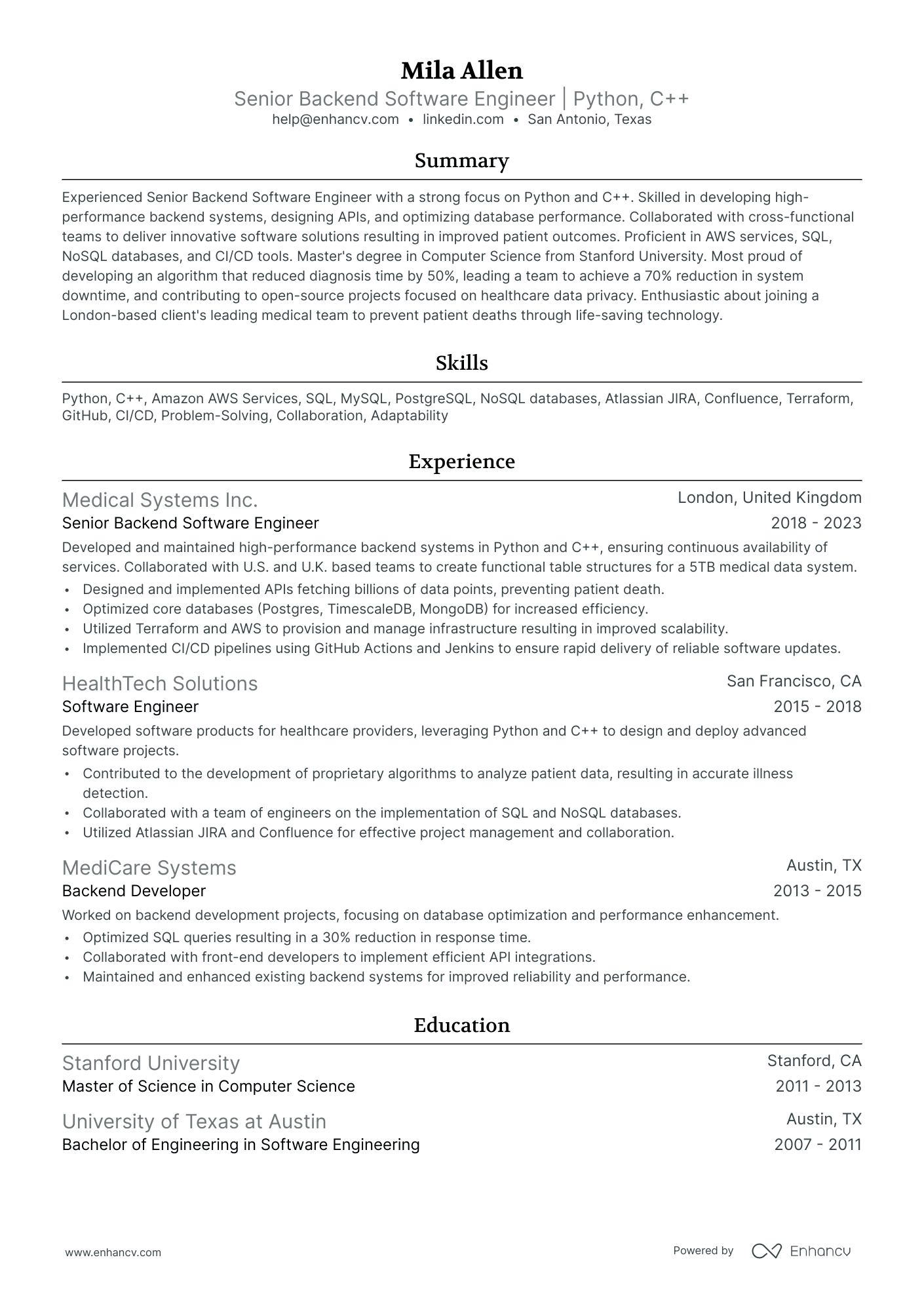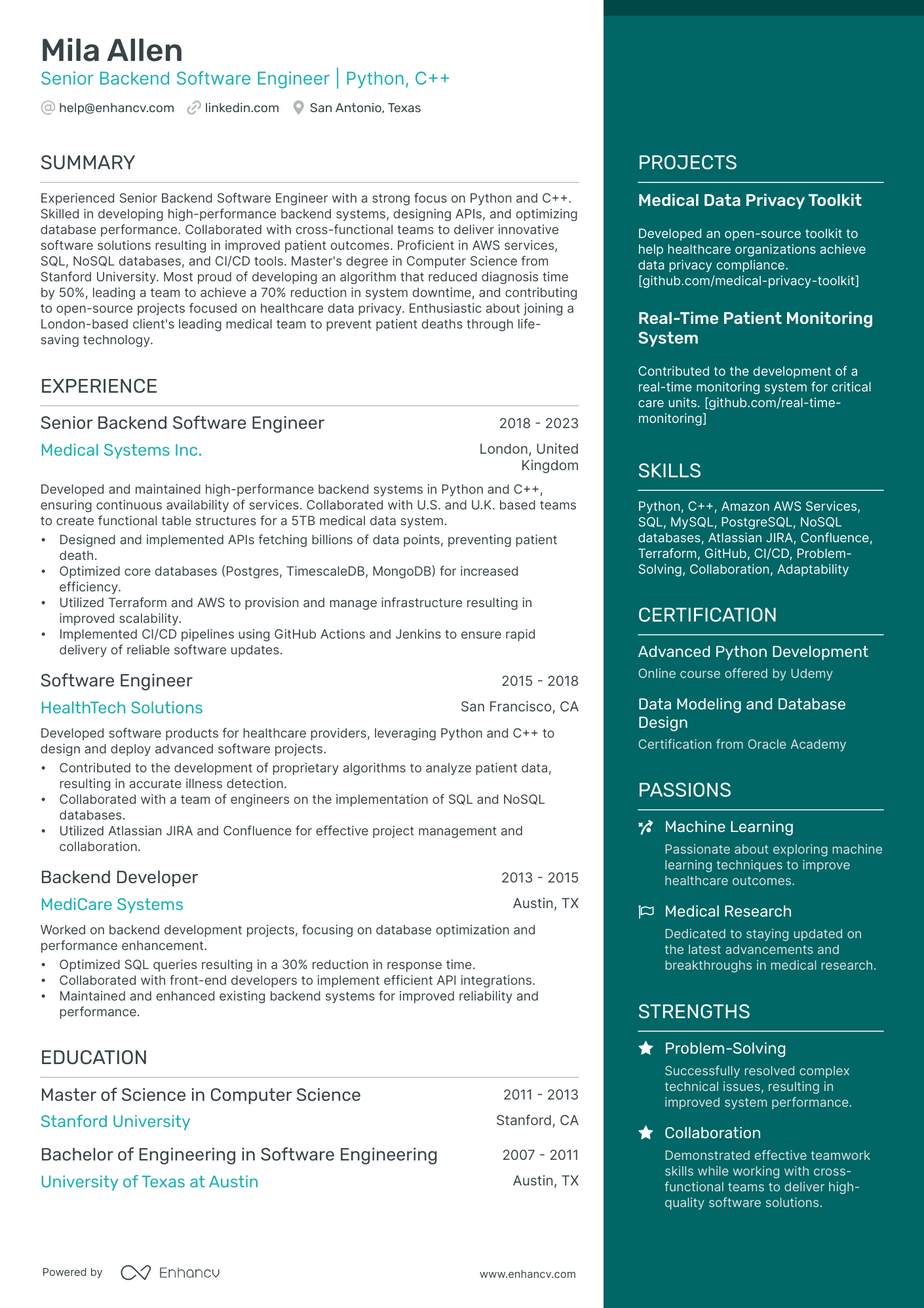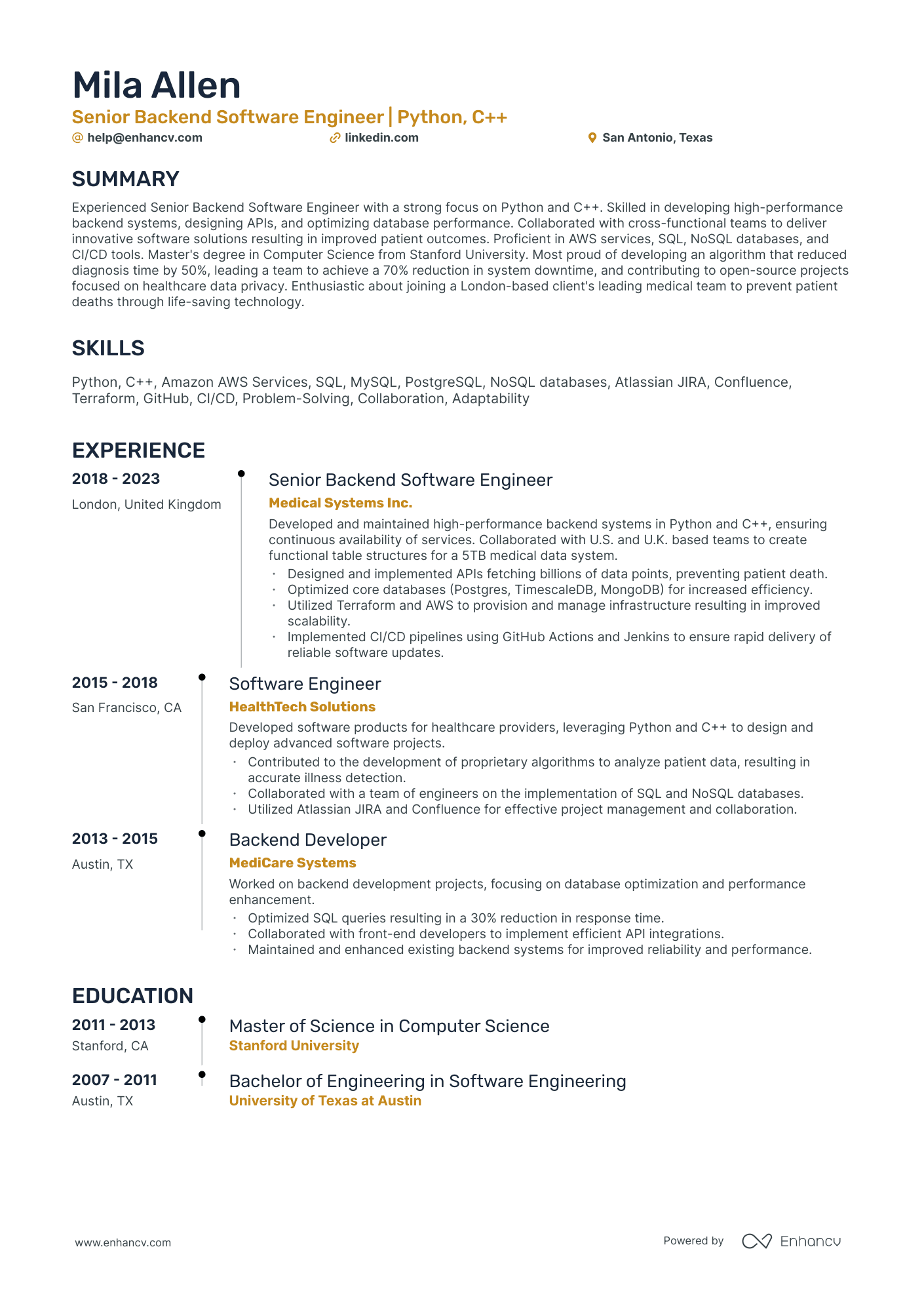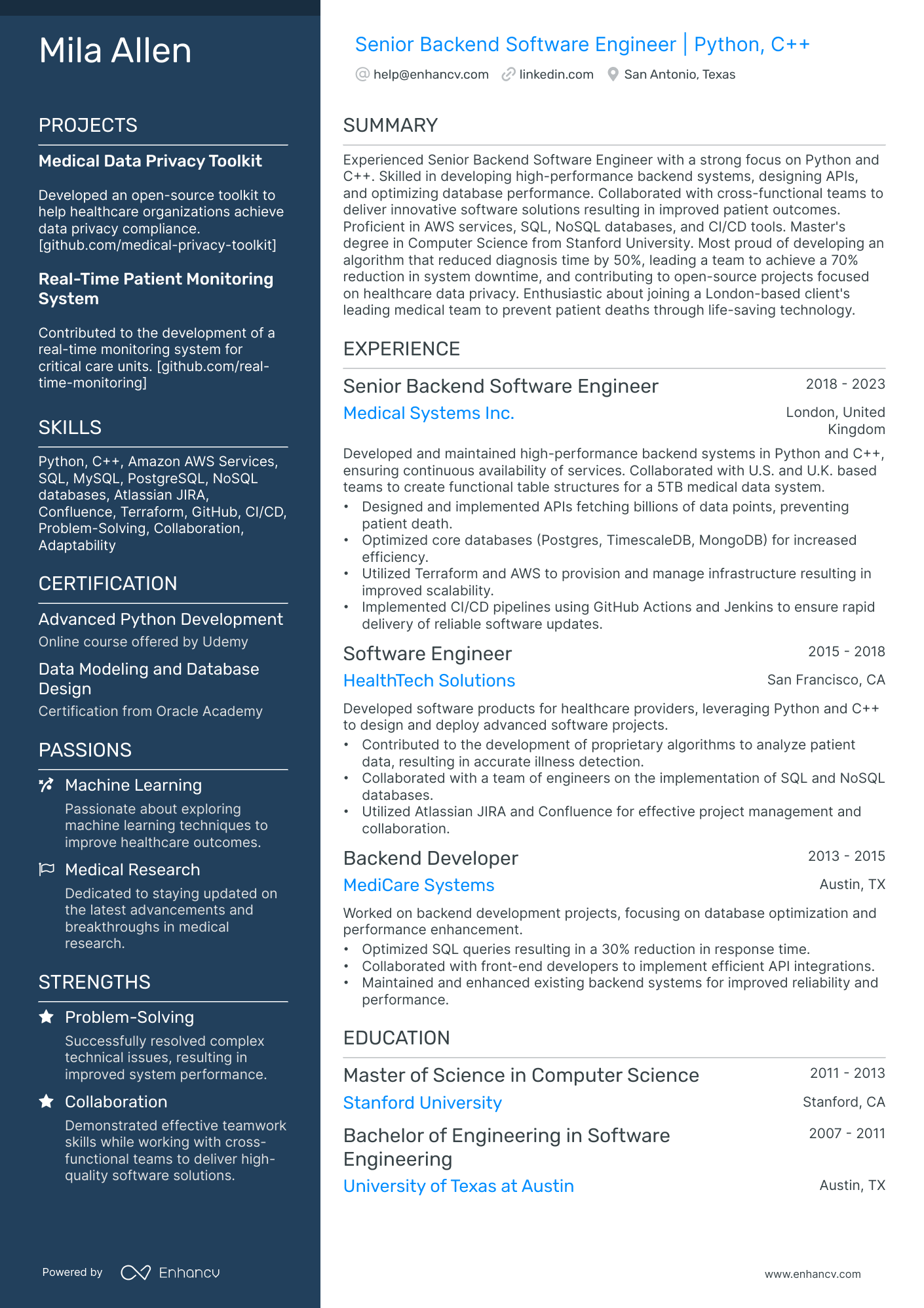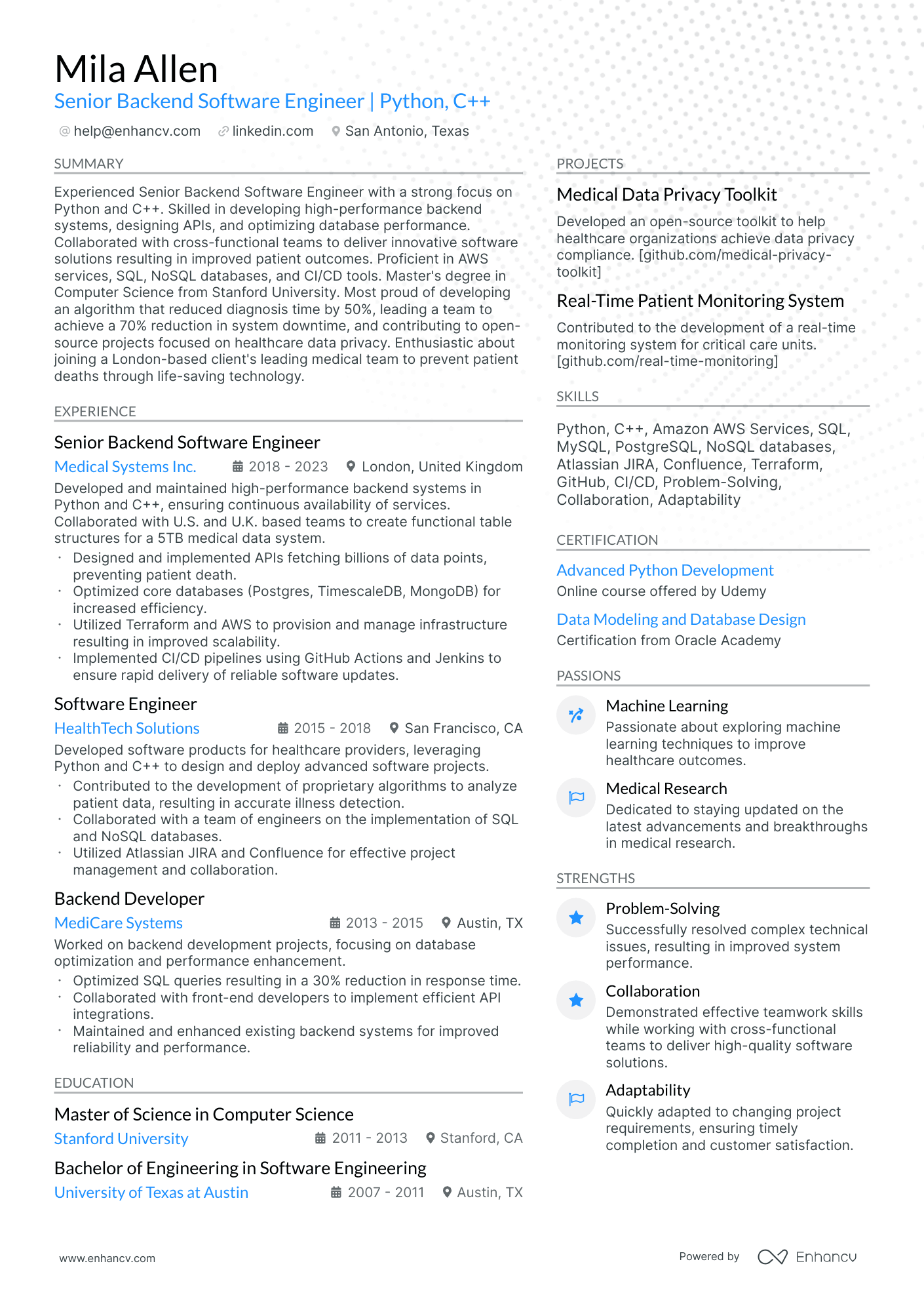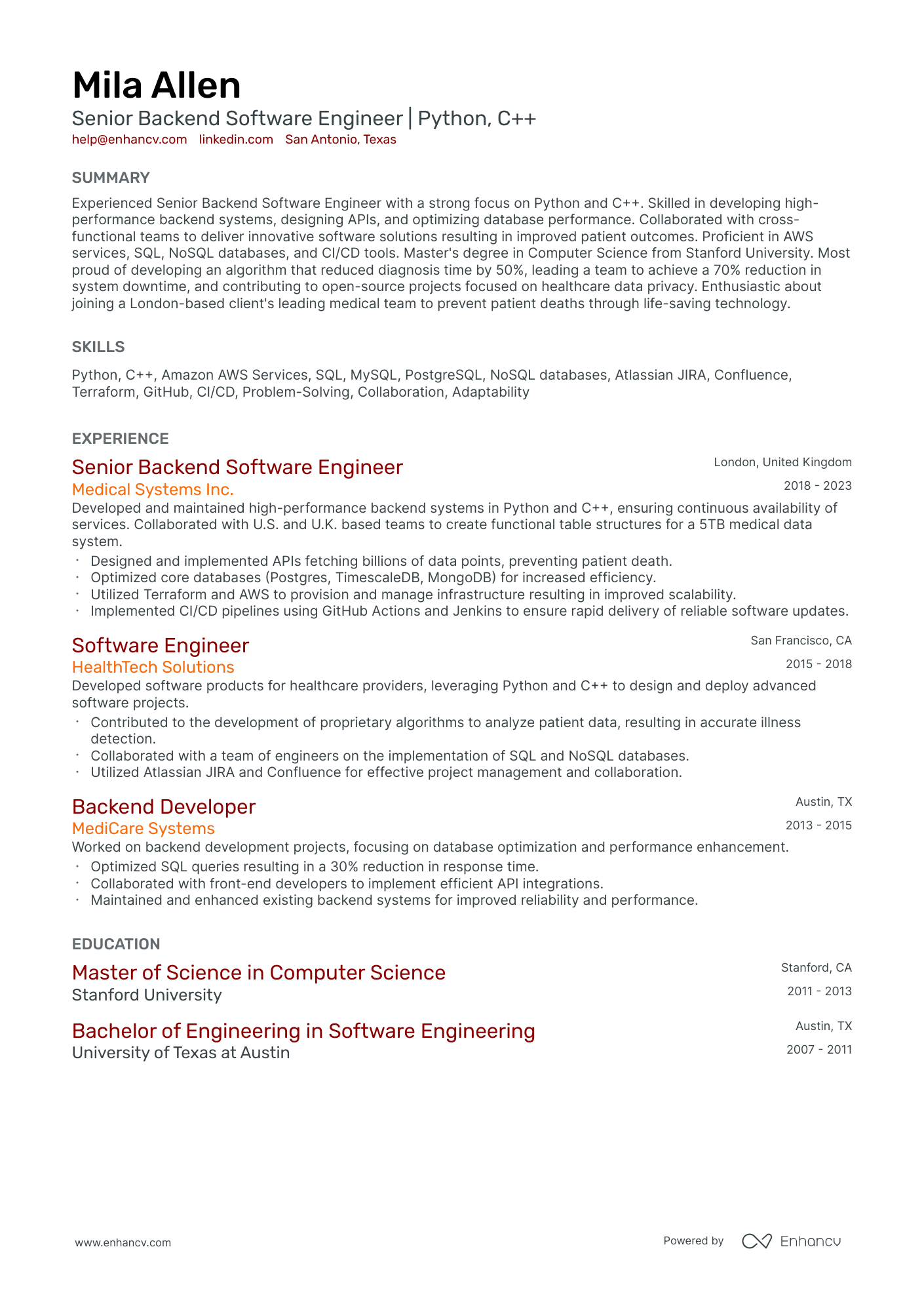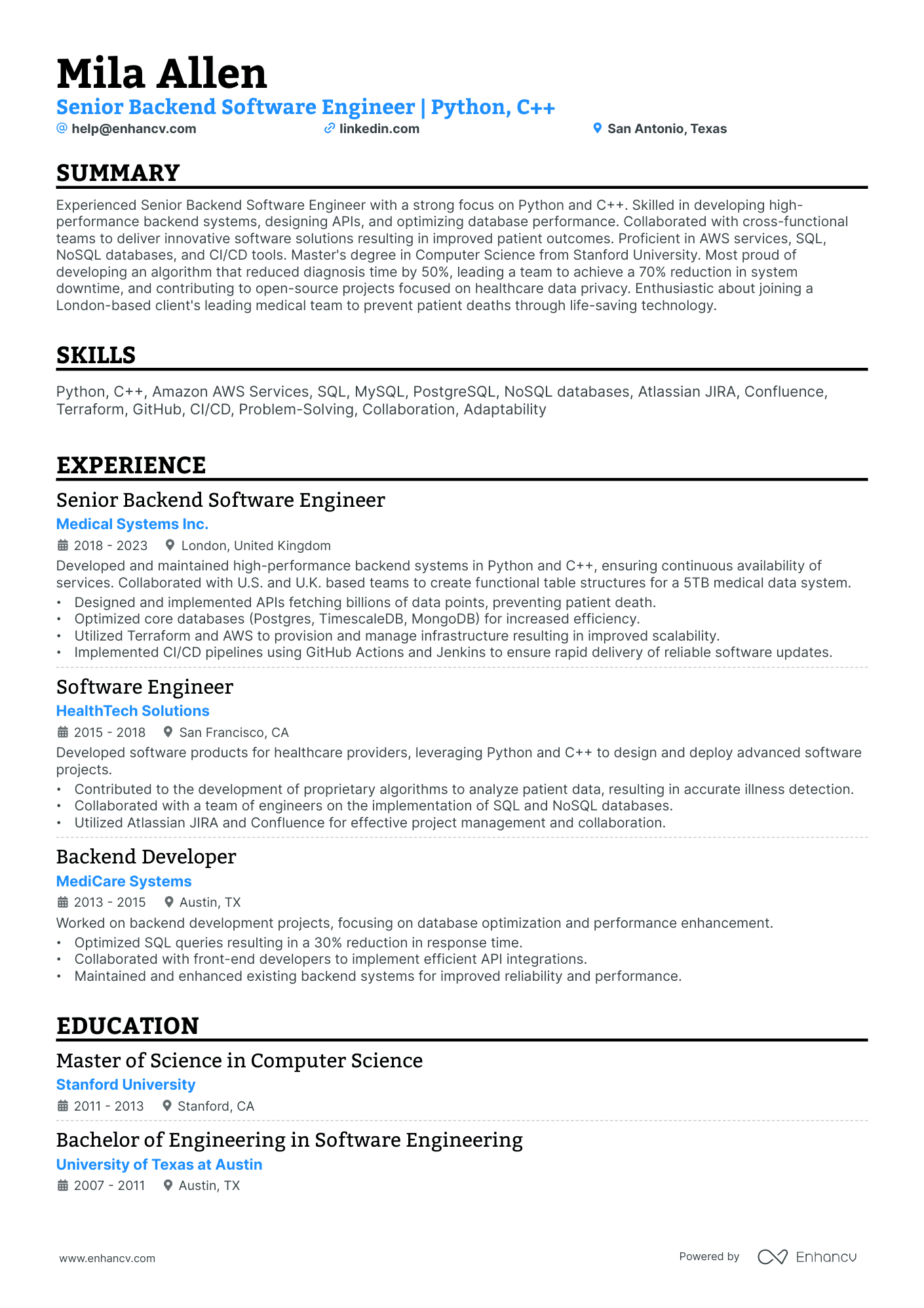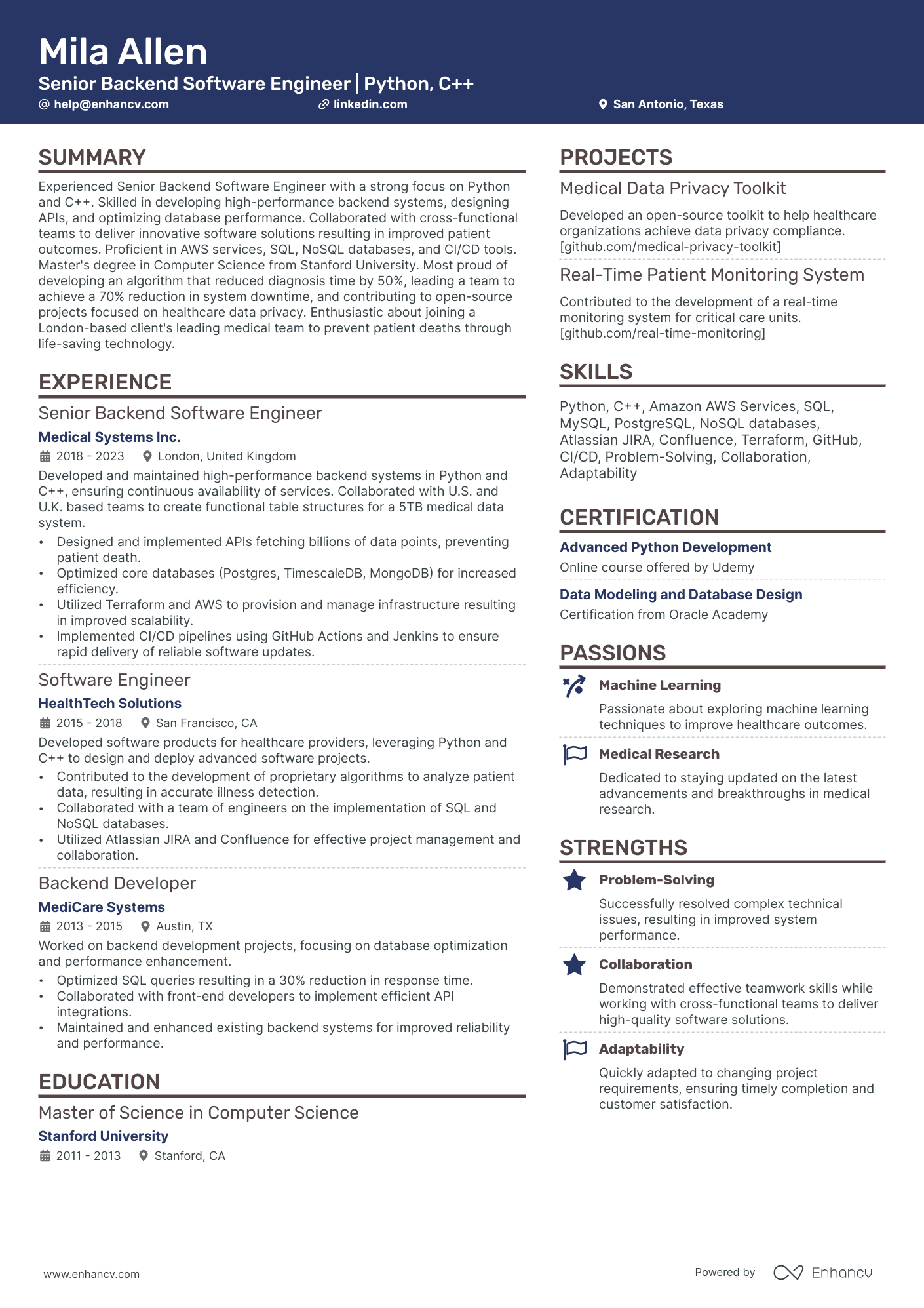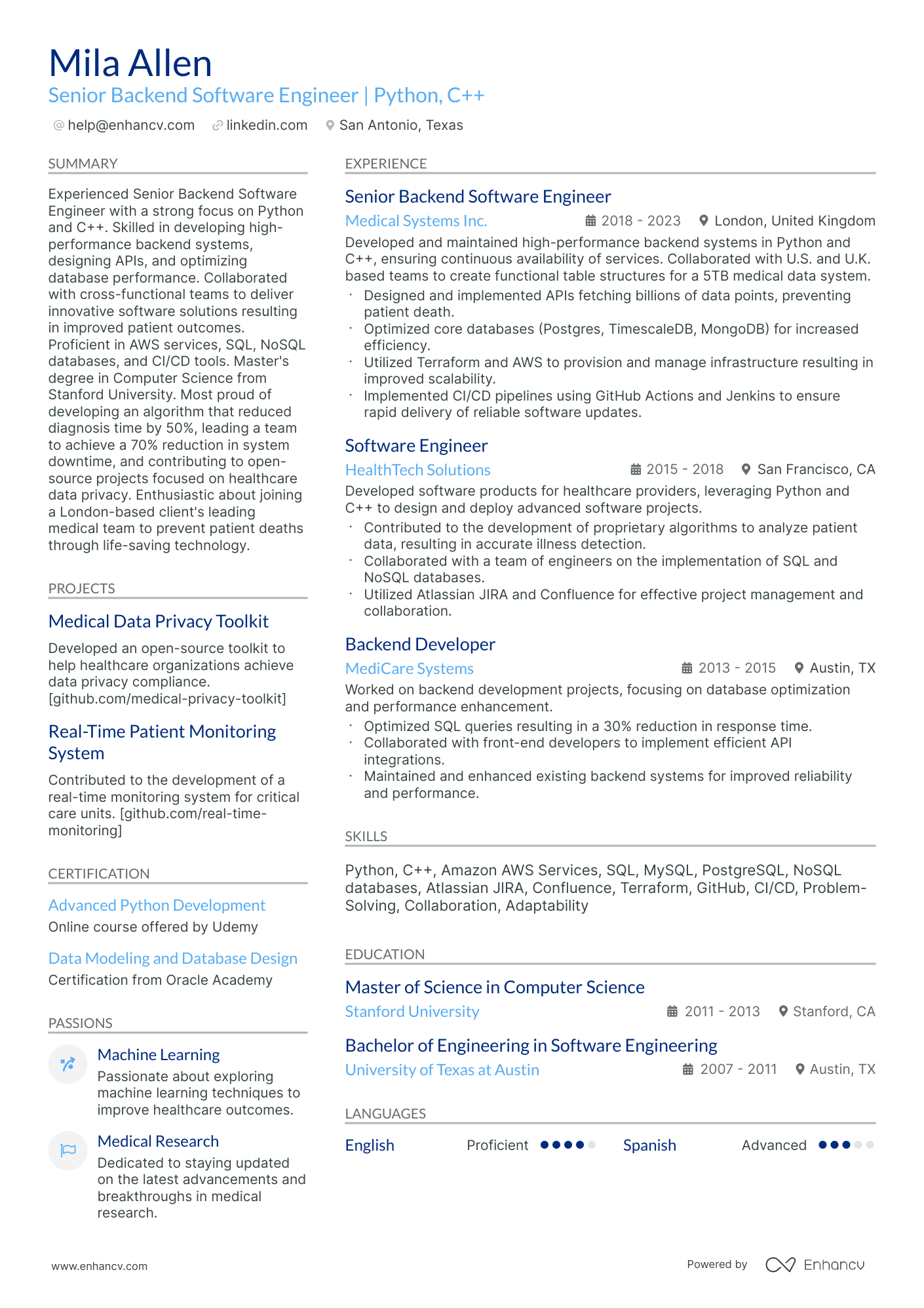One specific resume challenge faced by an AWS cloud engineer is demonstrating the extent of their technical expertise and breadth of experience with various AWS services concisely. Our guide can assist in addressing this challenge by providing industry-specific templates and actionable tips on how to highlight key skills, projects, and accomplishments in a clear, succinct manner that appeals to potential employers.
Dive into our concise guide to learn how to:
- Show your AWS cloud engineer career's brightest moments through your resume's summary, objective, and experience sections.
- Explore top-notch AWS cloud engineer resume examples to understand how to distinguish yourself from other candidates.
- Identify the most sought-after AWS cloud engineer skills and certifications in the industry.
- Design a structured yet unique resume layout.
Recommended reads:
Formatting the layout of your AWS cloud engineer resume: design, length, and more
When it comes to the format of your AWS cloud engineer resume , you've plenty of opportunities to get creative. But, as a general rule of thumb, there are four simple steps you could integrate into your resume layout.
- If you have plenty of experience, you'd like to showcase, invest in the reverse-chronological resume format. This format focuses on your latest experience items and skills you've learned during your relevant (and recent) jobs.
- Don't go over the two-page limit, when creating your professional AWS cloud engineer resume. Curate within it mainly experience and skills that are relevant to the job.
- Make sure your AWS cloud engineer resume header includes all of your valid contact information. You could also opt to display your professional portfolio or LinkedIn profile.
- Submit or send out your AWS cloud engineer resume as a PDF, so you won't lose its layout and design.
Adjust your resume layout based on the market – Canadian resumes, for example, may follow a unique format.
Upload your resume
Drop your resume here or choose a file. PDF & DOCX only. Max 2MB file size.
Pro tip
Your resume will likely be processed by an Applicant Tracking System (ATS). Ensure your header, summary, or objective incorporates essential skills required for the role.
Essential components for your real estate attorney resume:
- Header: Feature your name prominently. If you have a notable degree or certification, append it next to your name. Include contact details, a link to your portfolio, and a concise headline.
- Summary or Objective: Align your professional trajectory and standout achievements with the desired role.
- Experience: Craft concise bullet points, highlighting tangible successes and contributions.
- Skills: Showcase them throughout your resume and consider a dedicated sidebar for emphasis.
- Education & Certifications: Reinforce your credibility and demonstrate your commitment to the industry.
What recruiters want to see on your resume:
- Experience with AWS services: Experience working with a wide range of Amazon Web Services like EC2, S3, RDS, ELB, etc. is critical for a Cloud Engineer role.
- Certifications: Having relevant certifications such as AWS Certified Solutions Architect, SysOps Administrator, or DevOps Engineer can greatly enhance the attractiveness of a resume.
- Knowledge in Infrastructure as Code (IaC): Proficiency in IaC tools such as AWS CloudFormation or Terraform is highly sought after.
- DevOps Experience: Having experience in implementing CI/CD pipelines through tools like Jenkins, GitLab CI/CD or AWS CodePipeline is crucial.
- Programming skills: Familiarity with popular programming languages such as Python, Node.js, or Java and scripting languages like Bash or PowerShell can be very valuable.
Recommended reads:
Strategies for crafting your AWS cloud engineer resume experience section
When detailing your AWS cloud engineer resume experience, it's essential to pair responsibilities with tangible achievements.
Consider including:
- Key responsibilities, emphasizing their significance to your role, team, or organization.
- Experiences that have fostered your technical acumen or professional growth.
- Metrics that underscore your contributions and successes.
- Challenges you've addressed and the solutions you've implemented.
- Strategies you've devised and their measurable impact on growth.
Your experience section is pivotal in making a lasting impression on recruiters. To inspire you, we've curated real-world AWS cloud engineer examples:
- Implemented scalable and highly available AWS infrastructure using EC2, S3, and RDS resulting in a 30% improvement in system performance.
- Designed and deployed automated CI/CD pipelines on AWS using CodePipeline and Jenkins, reducing deployment time by 50%.
- Developed and maintained infrastructure as code using CloudFormation templates, enabling consistent and repeatable deployments across multiple environments.
- Optimized cost management strategies by implementing AWS Cost Explorer and leveraging spot instances, leading to a 20% reduction in monthly infrastructure expenses.
- Performed regular security audits and implemented best practices for AWS IAM roles, policies, and security groups, ensuring compliance with industry standards.
- Migrated on-premises infrastructure to AWS cloud environment, resulting in increased scalability and reduced operational costs by 40%.
- Designed and implemented disaster recovery solutions using AWS services such as AWS Backup and AWS CloudFormation, ensuring business continuity in case of system failures.
- Automated monitoring and alerting processes using CloudWatch, enabling proactive identification and resolution of performance issues.
- Collaborated with cross-functional teams to design and implement secure VPC architectures with VPN connectivity to on-premises networks.
- Led a team of engineers in the successful implementation of a serverless architecture using AWS Lambda and API Gateway, resulting in improved application performance and reduced maintenance efforts.
- Built and managed scalable AWS infrastructure using services like EC2, DynamoDB, and Elastic Beanstalk, supporting a high-traffic web application.
- Implemented automated backup and recovery processes using AWS Backup and Amazon S3 versioning, ensuring data integrity and availability.
- Optimized application performance by fine-tuning AWS resources and implementing caching mechanisms resulting in a 40% reduction in response time.
- Developed and maintained CI/CD pipelines using AWS CodePipeline and Git, enabling frequent and reliable application deployments.
- Collaborated with development teams to design and implement secure authentication and authorization mechanisms using AWS Cognito and IAM.
- Provisioned and configured AWS resources including EC2 instances, RDS databases, and VPCs based on project requirements.
- Managed and monitored system performance using CloudWatch, identifying and resolving bottlenecks to ensure optimal application performance.
- Implemented disaster recovery strategies using AWS Backup and performed regular backups and restoration tests to maintain data integrity.
- Collaborated with cross-functional teams to design and implement secure network architectures with private and public subnets.
- Troubleshot and resolved production issues related to AWS infrastructure, ensuring minimal downtime and maximum availability.
- Assisted in the migration of legacy systems to AWS cloud environment, ensuring seamless transition and improved scalability.
- Implemented AWS IAM policies, roles, and permissions to enforce granular access control and maintain data security.
- Configured and maintained auto-scaling groups and load balancers to handle varying application traffic and ensure high availability.
- Collaborated with development teams to optimize application architecture for cloud deployment, resulting in improved performance and cost-efficiency.
- Provided technical support and troubleshooting assistance to development teams for AWS-related issues.
- Designed and implemented serverless architecture on AWS using Lambda and API Gateway, resulting in reduced infrastructure costs by 50%.
- Migrated legacy applications to AWS ECS and EKS clusters, improving scalability and reducing operational overhead.
- Developed automation scripts using AWS SDKs and CLI to streamline provisioning and configuration management processes.
- Implemented monitoring and logging solutions using CloudWatch and ELK stack, enabling real-time visibility and proactive issue resolution.
- Collaborated with DevOps teams to implement infrastructure as code practices using tools like Terraform and Ansible.
- Managed and optimized AWS infrastructure, including EC2 instances, RDS databases, and Elastic Load Balancers, resulting in improved system performance.
- Implemented automated deployment pipelines using AWS CodePipeline and Jenkins, reducing deployment time by 30%.
- Performed security assessments and implemented best practices for securing AWS resources, resulting in compliance with industry standards.
- Collaborated with development teams to design and implement scalable architectures using AWS services like Lambda and DynamoDB.
- Configured and maintained VPN connections to securely connect on-premises networks with AWS VPCs.
- Implemented highly available and fault-tolerant architectures on AWS using services like EC2 Auto Scaling, Elastic Load Balancing, and Route 53.
- Designed and deployed containerized applications using AWS ECS clusters, improving scalability and resource utilization.
- Automated infrastructure provisioning and configuration management using AWS CloudFormation and Ansible, reducing manual efforts by 70%.
- Optimized application performance by implementing caching mechanisms using AWS ElastiCache resulting in a 40% reduction in response time.
- Collaborated with cross-functional teams to define and enforce security policies for AWS resources, ensuring data confidentiality and integrity.
- Led the migration of on-premises databases to Amazon RDS, improving scalability and reducing maintenance efforts by 50%.
- Implemented AWS Lambda functions to automate serverless workflows, resulting in improved operational efficiency.
- Developed and maintained infrastructure as code using AWS CloudFormation, enabling consistent and reproducible deployments.
- Optimized AWS costs by leveraging Reserved Instances and Spot Instances, resulting in a 30% reduction in monthly expenses.
- Collaborated with DevOps teams to design and implement monitoring and logging solutions using CloudWatch and ELK stack.
- Designed and deployed fault-tolerant architectures on AWS using services like EC2, RDS, and Auto Scaling Groups.
- Implemented disaster recovery strategies using AWS Backup and performed regular backup tests to ensure data availability.
- Automated infrastructure deployment and configuration using AWS CloudFormation and Ansible, reducing time-to-market by 40%.
- Optimized application performance by implementing CDN solutions using AWS CloudFront, resulting in a 50% reduction in latency.
- Collaborated with cross-functional teams to design secure network architectures with VPC peering and VPN connectivity.
Quantifying impact on your resume
<ul>
Building a AWS cloud engineer resume when experience is sparse
If you're light on relevant experience, consider highlighting:
- Short-term roles or internships undertaken during your academic years.
- Contractual roles, emphasizing their relevance and the outcomes achieved.
- Alternative resume formats, such as functional or hybrid, that spotlight your skills.
- Research roles, especially if they involved significant projects or if your contribution was pivotal to the project's success.
Pro tip
Use the SOAR (Situation - Action - Results) method for each of your AWS cloud engineer experience bullets. Reflect on specific challenges you've addressed, the actions you took, and the outcomes. This approach also preps you for potential interview questions.
How to create an impactful AWS cloud engineer resume skills section
Recruiters always care about the skill set you'd bring about to the AWS cloud engineer role. That's why it's a good idea to cherry pick yours wisely, integrating both hard (or technical) and soft skills.
Hard skills are gained through studying, are certifiable, and it's impossible to do your job without them. All in all, they show your suitability for the technical aspect of the role.
Your soft skills are those personality traits you've gained over time and most often than not - outside of the workplace. Soft skills are more difficult to quantify but are definitely worth it - as they show how you'll fit and adapt into a new team environment.
How do you build the skills section of your resume?
- Include up to five or six skills in the section as keywords to align with the advert.
- Create a specific technical skills section to highlight your hard skills aptitude.
- Read more about the culture of the company you're applying and cherry pick the soft skills you have that deserve a mention.
- Make sure you answer the majority of the job requirements that are in the advert within your skills section.
A AWS cloud engineer's resume requires a specific skill set that balances both industry-specific hard skills with personal, soft skills. Discover the most often used ones on AWS cloud engineer resumes from our list:
Top skills for your AWS cloud engineer resume:
AWS Services (EC2, S3, RDS, Lambda)
Infrastructure as Code (CloudFormation, Terraform)
Containerization (Docker, Kubernetes)
Networking (VPC, Route 53, Security Groups)
Database Management (RDS, DynamoDB, Aurora)
Monitoring and Logging (CloudWatch, CloudTrail)
CI/CD Tools (Jenkins, CodePipeline)
Scripting Languages (Python, Bash, PowerShell)
Identity and Access Management (IAM)
Serverless Architecture
Problem-Solving
Communication
Team Collaboration
Adaptability
Time Management
Attention to Detail
Critical Thinking
Project Management
Customer Service Orientation
Continuous Learning
Pro tip
Don't go all over the place with your skills section by listing all keywords/ buzzwords you see within the ad. Curate both hard and soft skills that are specific to your professional experience and help you stand out.
Highlighting certifications and education on your AWS cloud engineer resume
Your academic achievements, including certifications and degrees, bolster your application. They showcase your skills and commitment to the field.
To effectively present these on your resume:
- Highlight significant academic achievements or recognitions relevant to the role.
- Be selective; prioritize the most relevant and impressive certifications.
- Include essential details: certificate/degree name, institution, graduation dates, and license numbers (if applicable).
- Present your academic background in reverse chronological order, emphasizing the most recent and relevant qualifications.
For further guidance, explore popular industry certifications.
Best certifications to list on your resume
Pro tip
Remember, certifications can be woven into various resume sections, like experience or summary. Detail how a particular certification enhanced your performance or opened new opportunities.
Recommended reads:
Choosing between a resume summary or objective
Many AWS cloud engineer candidates ponder whether to include a resume summary or objective.
Here's a breakdown:
- A Resume objective outlines your career aspirations. It tells recruiters why you're applying and the value you can bring.
- A Resume summary offers a snapshot of your significant achievements, giving a quick overview of your expertise.
New professionals might lean towards an objective, while seasoned experts might prefer a summary. Whichever you choose, ensure it's tailored to the role.
For inspiration, review examples from established AWS cloud engineer professionals.
Resume summary and objective examples for a AWS cloud engineer resume
- Accomplished AWS cloud engineer with 8 years' experience in high-paced tech companies. Expertise in the management and deployment of AWS services, improving infrastructure scalability, and executing fault-tolerant systems. Led data migration project resulting in 40% performance improvement.
- Seasoned professional in the IT sector, now eager to apply my extensive 10-year experience to cloud engineering. Possesses an excellent grasp of Python and Java along with a firm foundation in Linux. Successfully led a team to win a national cybersecurity competition.
- Pro-active IT specialist with a 7-year track record, making a transition to a Cloud Engineer role. Holds a deep understanding of network protocols and database management systems. Known for implementing cost-saving measures that reduced annual IT spending by $200k at previous employer.
- Experienced Network Administrator with 5 years in the industry, seeking to leverage background into cloud computing. Familiar with scripting languages like Python, Bash, and Perl. Played pivotal role in increasing network uptime from 95% to 99.9% at last workplace.
- As a recent Computer Science graduate, I am enthusiastic about applying the concepts learned during my coursework, such as distributed systems and machine learning algorithms, to practical scenarios in cloud engineering. Eager to use my skills in Python and MySQL to contribute to large-scale projects.
- With a newly minted degree in Information Technology and zero work experience, my goal is to work as a cloud engineer where I could utilize skills gained through rigorous academic training, including proficiency in C++ and SQL. Looking forward to mastering AWS services and processes.
Optimize your resume summary and objective for ATS
Drop your resume here or choose a file.
PDF & DOCX only. Max 2MB file size.
Extra sections to boost your AWS cloud engineer resume
Recruiters love candidates who offer more. Share your personality or extra industry credentials. Consider adding:
- Projects showcasing standout work.
- Top awards or recognitions.
- Relevant publications.
- Hobbies and interests that reveal more about you.
Key takeaways
- A clear resume layout helps present your info well.
- Use all main resume sections to show how you fit the job.
- Detail specific skills or tasks and their impact.
- Show your personality through interests or hobbies.
- List certifications to back up your technical skills.
